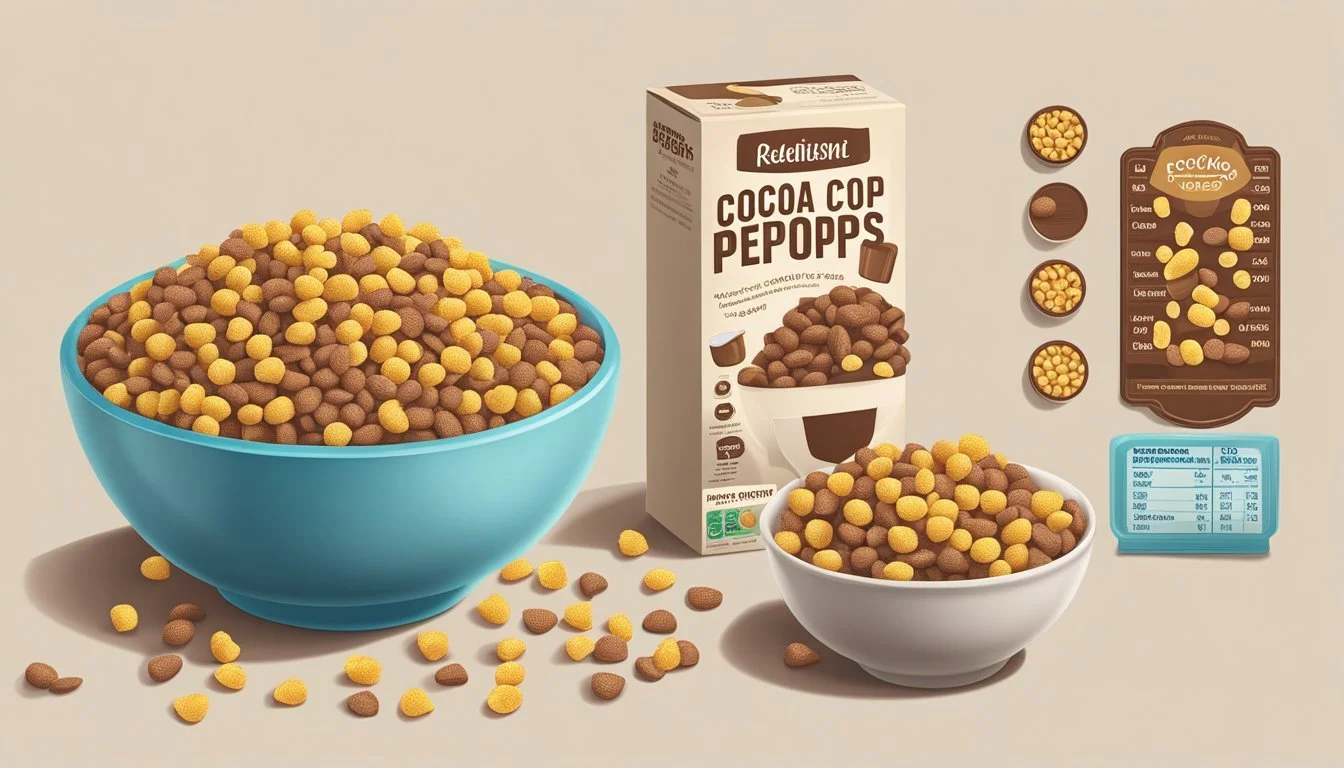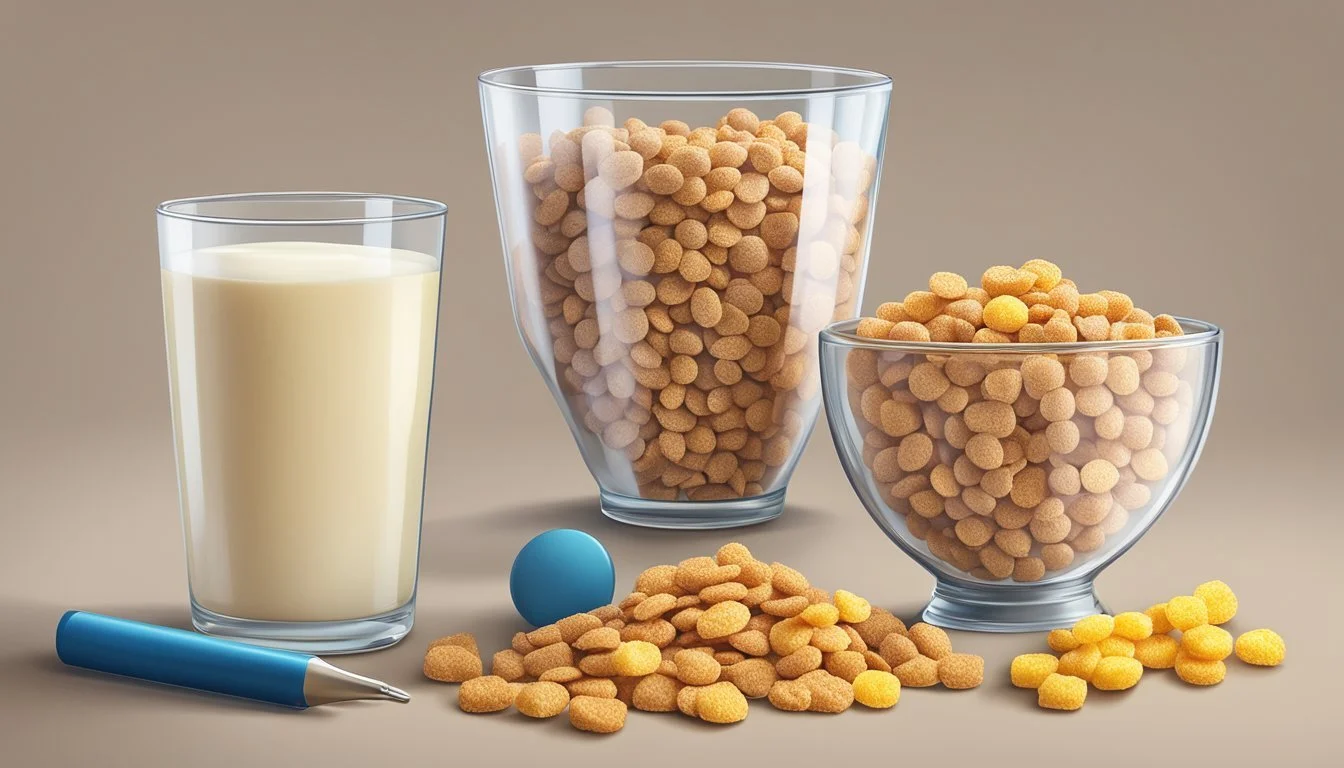Cocoa Pebbles vs Corn Pops
Nutritional Comparison and Taste Test
This Article is Part of Our Breakfast Cereal Guide with Details on Cocoa Pebbles Nutrition and Corn Pops Nutrition
When comparing Cocoa Pebbles and Corn Pops, it’s clear that each cereal has its unique appeal. Cocoa Pebbles offer a chocolatey crunch that many find irresistible, while Corn Pops bring their own fun, popping sensation to the breakfast table. Those who prioritize a higher fiber content and Vitamin C may lean towards Corn Pops, while option seekers favoring vitamins A, D, and B12 might prefer Cocoa Pebbles.
Cocoa Pebbles are notably rich in essential vitamins, providing an excellent source of Vitamin A, D, and several B vitamins. Corn Pops, on the other hand, rank higher in fiber, which can be a crucial factor for those looking to increase their daily intake of fiber. Nutritionally, the choice depends on individual dietary needs and preferences.
The consumer experience varies significantly with these two cereals. The rich, chocolate flavor of Cocoa Pebbles is a delight for cocoa lovers, whereas the airy, light texture of Corn Pops provides a unique, mouth-popping experience. This blend of flavors and textures makes each morning a special treat, whether one prefers the sweetness of chocolate or the lightness of corn.
Cereal Profile
When comparing Cocoa Pebbles and Corn Pops, one must consider key elements such as nutritional content, flavor, and serving size. This section provides an in-depth look at each cereal's features and benefits.
Cocoa Pebbles Overview
Cocoa Pebbles is a chocolate-flavored cereal known for its rich, sweet taste. A single serving size of 1 cup contains 140 calories. These cereals do not have any saturated or trans fats and contain 220 mg of sodium. Potassium levels are at 60 mg per serving.
Regarding vitamins and minerals, Cocoa Pebbles has notable amounts of Vitamin A, Vitamin D, Vitamin B12, and Copper. It is relatively low in fiber but provides some essential nutrients that contribute to a balanced diet. Whole grains and high-quality grains are absent in this cereal, focusing more on taste and an enjoyable eating experience.
Corn Pops Features
Kellogg's Corn Pops is a corn-based cereal that offers a crunchy texture and a sweet flavor. A typical serving size is 1 1/3 cup, providing 150 calories. This cereal also delivers 3 grams of protein and 260 mg of sodium per serving. Corn Pops are higher in fiber compared to Cocoa Pebbles, making it a slightly healthier option for digestive health.
Corn Pops contain a mix of vitamins and minerals, including Vitamin C and some protein. Although this cereal can be part of a balanced diet, it's important to consume it in moderation due to its sugar content. Unlike Cocoa Pebbles, Corn Pops do not offer the strong chocolate flavor but focus more on the natural sweetness of corn.
Both cereals provide enjoyable eating experiences with distinct flavor profiles.
Nutritional Comparison
When comparing Cocoa Pebbles and Corn Pops, it is essential to examine multiple nutritional aspects. This includes macronutrient content, vitamin and mineral presence, sugar levels, and fiber benefits.
Macronutrient Content
Calories: Cocoa Pebbles generally offer around 120 calories per serving, while Corn Pops typically contain about 110 calories.
Carbs and Protein: Cocoa Pebbles contain approximately 27 grams of carbs and 1 gram of protein. Corn Pops have about 26 grams of carbs and 2 grams of protein.
Fats: Both cereals are low in fat, with Cocoa Pebbles containing about 1 gram and Corn Pops containing 0 grams per serving.
Vitamins and Minerals
Cocoa Pebbles are particularly rich in Vitamin B12, providing a significant portion of daily needs. Other vitamins like Vitamin B2, Vitamin D, and Vitamin A are also notable in Cocoa Pebbles.
Corn Pops shine in Vitamin C content and offer a better fiber source. Both cereals are fortified with essential minerals such as iron and calcium, but the specific content can vary.
Sugar Content Analysis
Both Cocoa Pebbles and Corn Pops are considered sugary cereals. Cocoa Pebbles typically contain around 9 grams of sugar per serving. Corn Pops are similar, with about 12 grams of sugar per serving.
High sugar content in both cereals can be a concern for those monitoring their sugar intake, but it also contributes to the taste appeal for many consumers.
Fiber and Whole Grain Benefits
Fiber Content: Corn Pops typically offer slightly more fiber compared to Cocoa Pebbles. For instance, Corn Pops have about 1 gram of fiber, compared to Cocoa Pebbles' 0.6 grams.
Whole Grains: Neither cereal is particularly high in whole grains. Popcorn as a reference, contains significantly more fiber than both cereals, highlighting an area for improvement in both of these options.
These comparisons help consumers decide based on specific nutritional needs and preferences.
Diet and Health Impact
When comparing Cocoa Pebbles and Corn Pops, it is essential to consider heart health, dietary impacts, and potential allergy concerns. Both cereals offer different nutritional benefits and considerations for breakfast choices.
Heart Health and Cholesterol
Cocoa Pebbles and Corn Pops both have implications for heart health, primarily regarding sugar and fiber content. Cocoa Pebbles contain minimal fiber, which plays a crucial role in reducing bad cholesterol levels. The fiber content in Corn Pops is also low but marginally higher than in Cocoa Pebbles.
Cocoa Pebbles:
Fiber: 1.6g per serving
Saturated Fat: 0g
Corn Pops:
Fiber: Higher than Cocoa Pebbles, exact value varies
Saturated Fat: 0g
High sugar content in both cereals can have adverse effects on heart health if consumed excessively. Reducing sugar intake and pairing these cereals with fiber-rich foods can help mitigate potential negative impacts.
Dietary Considerations
Cocoa Pebbles and Corn Pops are often evaluated based on their carbohydrate, calorie, and vitamin and mineral content. Cocoa Pebbles are rich in essential vitamins such as Vitamin B12, Vitamin D, and folate, making them attractive for a nutrient-rich diet. Corn Pops, on the other hand, are relatively low in calories and fats, fitting well within low-fat and low-cal diets.
Cocoa Pebbles: High in vitamins (B12, D) but also high in sugar
Corn Pops: Lower in calories, sugar content still significant
For those watching their glycemic index, both cereals may cause blood sugar spikes due to their high sugar content. Opting for them occasionally rather than daily can be a smarter dietary choice.
Allergy and Sensitivity Concerns
Both Cocoa Pebbles and Corn Pops contain allergens that may pose risks to individuals with specific sensitivities. Cocoa Pebbles may contain gluten, making them unsuitable for those with gluten intolerance or celiac disease. Corn Pops may contain allergens such as corn, which can cause reactions in some individuals.
Cocoa Pebbles: Potential gluten content
Corn Pops: Contains corn, possible allergen
Label examination for both cereals is crucial for those with food allergens or sensitivities. Always check for cross-contamination warnings and specific ingredient lists before consumption.
Choosing between Cocoa Pebbles and Corn Pops involves balancing nutritional benefits with dietary needs and potential allergens. Always consider personal health conditions and consult healthcare providers if in doubt.
Consumer Information
Consumers looking at Cocoa Pebbles and Corn Pops often compare their pricing, value, packaging, and availability. These factors play an essential role in their purchasing decisions and influence which cereal is more suitable for their needs and preferences.
Pricing and Value
Cocoa Pebbles generally retail for approximately $3.50 to $4.50 per box weighing 11-15 oz.
In comparison, Corn Pops are priced similarly, ranging from $3.00 to $4.00 for a 12-15 oz box.
Considering the nutritional content and portion sizes, Cocoa Pebbles offers a chocolatey experience, albeit higher in sugar. Corn Pops, while less sugary, can be considered slightly higher in value due to its fiber content. Sales and promotions in supermarkets frequently affect these prices. Both cereals are available in larger family-sized boxes for those looking for more value.
Packaging and Availability
Cocoa Pebbles are typically packaged in colorful boxes featuring characters from popular media, appealing mainly to children. The packaging is designed to retain the cereal's freshness and is easy to reseal.
Corn Pops also come in eye-catching containers but emphasize the cereal's classic, beloved status. Both cereals are widely available in supermarkets and can be purchased online through major retailers such as Amazon and Walmart.
Product availability may depend on location, with urban areas having more consistent stock. The colorful and attractive packaging of both cereals caters to both convenience and longevity, ensuring continued consumer interest.
Comparative Alternatives
When comparing Cocoa Pebbles and Corn Pops, it's essential to consider similar cereal alternatives and healthier substitute options. Each option offers unique nutritional benefits and flavors that might appeal more to different dietary preferences or needs.
Similar Cereal Alternatives
In terms of flavor, similar alternatives to Cocoa Pebbles include Fruity Pebbles, Cocoa Krispies, and Cocoa Puffs. These cereals typically cater to those preferring sweet, chocolate-flavored breakfasts.
Fruity Pebbles: Bright, fruity flavors.
Cocoa Krispies: Similar chocolate taste with a slightly different texture.
Cocoa Puffs: Comparable in sweetness and chocolate flavor.
For Corn Pops, equivalents like Cinnamon Toast Crunch and Cheerios may appeal to readers looking for variety.
Cinnamon Toast Crunch: Sweet with a cinnamon twist.
Cheerios: Subtly sweet with whole-grain benefits.
Healthier Substitute Options
Considering health, cereals like Shredded Wheat, Raisin Bran, and Cheerios are preferable alternatives due to their lower sugar content and higher fiber levels.
Shredded Wheat: Low in sugar, high in fiber, minimal processing.
Raisin Bran: Offers the sweetness of raisins with the fiber from bran flakes.
Cheerios: Whole grain, low in sugar, good for heart health.
These substitutions can be especially advantageous for those focusing on fiber intake and reducing sugar consumption, making them excellent choices for a balanced diet.
Cultural and Brand Influence
Cocoa Pebbles and Corn Pops have both established significant cultural footprints through strategic marketing campaigns and a solid consumer base. Examining their advertising strategies and consumer loyalty sheds light on their lasting popularity.
Marketing Campaigns
Cocoa Pebbles has capitalized on pop culture through advertisements featuring beloved characters like Fred Flintstone. This branding move has helped the cereal remain relevant across generations. Post's ad campaigns, including those for limited editions like Candy Corn Pebbles and Poppin' Pebbles, have also kept the brand fresh.
Corn Pops, on the other hand, has leveraged slogans like "Gotta have my Pops" to create catchy, memorable campaigns. Kellogg’s has consistently targeted younger consumers, cementing the cereal’s place in breakfast culture. Influential ad placements and timely promotions have been crucial for both brands.
Consumer Loyalty and Perception
Both cereals enjoy significant brand loyalty. Cocoa Pebbles has built a dedicated following among fans of chocolate-flavored cereals, often drawing nostalgic consumer reviews praising its taste and texture. The cereal's connection to the Flintstones franchise also enhances its appeal.
Corn Pops has maintained a strong consumer base by appealing to those who prefer a sweeter, less intense flavor. Its light, crunchy texture stands out in product rankings and consumer reviews. Surveys indicate a high level of brand loyalty, often citing memories of childhood as a reason for continued purchases.






